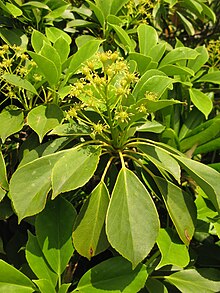Trochodendraceae
| Trochodendraceae Temporal range:
| |
|---|---|

| |
| Trochodendron aralioides | |
| Scientific classification | |
| Kingdom: | Plantae |
| Clade: | Tracheophytes |
| Clade: | Angiosperms |
| Clade: | Eudicots |
| Order: | Trochodendrales Cronquist
|
| Family: | Trochodendraceae Eichler |
| Genera | |
| |
Trochodendraceae is the only family of flowering plants in the order Trochodendrales. It comprises two extant genera, each with a single species[1] along with up to five additional extinct genera and a number of extinct species.[2] The living species are native to south east Asia. The two living species (Tetracentron sinense and Trochodendron aralioides) both have secondary xylem without vessel elements, which is quite rare in angiosperms. As the vessel-free wood suggests primitiveness, these two species have attracted much taxonomic attention.
Description
This section may be too technical for most readers to understand. (October 2020) |
Tetracentron and Trochodendron are deciduous or evergreen trees, which grow to between 20–30 m (66–98 ft) tall, with Trochodendron sometimes sporting umbrella-shaped branches.
- obovate, with a cordate to cuneate base and acuminate apex, stalked, with thin stipules fused with the petiole (Tetracentron) or absent (Trochodendron). Idioblasts present, large, branched, sclerenchymatous in Trochodendron and secretory in Tetracentron. Stomatalaterocytic or cyclocytic, hypostomatic.
- Stems without xylematic vessels, with tracheids, heterogeneous xylem, uni- and multi-seriate, branches clearly differentiated in unifoliate brachyblasts and macroblasts with distichous phyllotaxis (Tetracentron), with nodes (1-)3(-multi)-lacunar, with (1)3(-7) leaf stems.
- Hermaphroditic or androdioecious plants.
- Terminal Inflorescence in erect, aggregated racemiforms (botryoid or small panicles) (Trochodendron) or defined, axillary, multi-floral amentoid spikes with the flower in whorls of 4 (Tetracentron). Bracts and bracteoles present or absent.
- Perfect styles (stylodious), dry, papillose, decurrent ventral stigmas, 5-30 anatropous, apotropous, bitegmicous, crassinucelate, pendulous ovules per carpel, placentationmarginal in 2 series or apicoaxial.
- capsule or an aggregate of dorsally and ventrally dehiscent semicarpical follicles, with basal and external styles.
- Small, flattened, tapered , with 2 cotyledons.
- Pollen in small, granular, spheroidal, tricolpate, tectated-columelliform monads (10-20 μm in diameter), the surface with interwoven bars parallel to the edges of the colpus, which are granular.
- Chromosomal number: 2n = 48 in Tetracentron and 2n = 38, 40 in Trochodendron.
Ecology
Pollination is probably myriophyllous, even though Tetracentron shows a clear anemophilous syndrome. The pulverulent seeds are dispersed by the wind (anemochory). Trochodendron is present in both protandrous and protogynous forms that are self-compatible.
The plants are found in wooded formations, Trochodendron between 300 m and 2.700 m above sea level and Tetracentron between 1.100 m and 3.600 m above sea level.
Phytochemistry
Flavonoids (quercetin and kaempferol) and proanthocyanidins (cyanidin and delphinidin) are present. Epicuticular waxes are basically composed of nonacosan-10-ol.[citation needed] Tetracentron contains chalcones or dihydrochalcones. Trochodendron contains myricetin. Ellagic acid is absent.
Fossils
Trochodendron and the fossil genus Eotrochion are known from the Paleocene of Wyoming, which constitute the oldest records of the family.[2]
A diverse assemblage of trochodendraceous species have been described from the Eocene OKanagan Highlands in British Columbia and Northeastern Washington. The monotypic genera Paraconcavistylon and Pentacentron are accompanied by Tetracentron hopkinsii and the Trochodendron infructescence morphospecies Tr. drachukii plus the foliage morphospecies Tr. nastae.[3][2]
The fruit and wood genus Nordenskioeldia, along with the associated leaf morphogenus Zizyphoides have been considered part of Trochodendraceae, though phylogenetic analysis by Manchester et al (2020) suggested they might be better placed as a basal stem lineage in the Trochodendrales, rather than as a crown group member of the family Trochodendraceae.[2]
Systematic position
The Trocodendraceae are a group of flowering plants that include the clade
Classification
The current classification of Trochodendraceae is the APG IV system published in 2016, which maintains the circumscription of Trochodendraceae used in the APG III system published in October 2009. Unlike the APG and APG II systems, the later systems place the family as the only family in the order Trochodendrales. They also includes Tetracentron, synonymizing Tetracentraceae fully with Trochodenraceae.[4][5]
The
This segregation would lead to two families with one species each: Tetracentraceae with Tetracentron sinense and Trochodendraceae with Trochodendron aralioides.
The
Taxa included
The family includes two living genera with very different morphological characteristics:
- Palmate leaves, with stipules, deciduous. Perianth of 4 tepals. Stamens 4. Carpels 4. Ovules 5-6 per carpel. Axillary inflorescence in amentoid spike.
- Tetracentron Oliv., 1889. North-east India, Nepal, Bhutan, Burma, western and central China, Vietnam.
- Pinnate leaves, without stipules, evergreen. Perianth absent. Stamens 40-70. Carpels (4-)6-11(-17). Ovules 15-30 per carpel. Terminal racemiform inflorescence, erect.
- Trochodendron Siebold & Zucc., 1839. Japan, Taiwan, Korea.
References
- .
- ^ .
- S2CID 92201595.
- ^ Angiosperm Phylogeny Group (2009). An update of the Angiosperm Phylogeny Group classification for the orders and families of flowering plants: APG III. Botanical Journal of the Linnean Society 161: 105-121.
- ISSN 0024-4074.
Further reading
- Endress, P.K. (1993). "Trochodendraceae.". Kubitzki, K., Rohwer, J.G. & Bittrich, V. (Editores). The Families and Genera of Vascular Plants. II. Flowering Plants - Dicotyledons. Springer-Verlag: Berlín. ISBN 978-3-540-55509-4.
- Watson, L., and Dallwitz, M.J. (1992). "The families of flowering plants: descriptions, illustrations, identification, and information retrieval. Version: 29th July 2006". Retrieved 31 January 2007.
{{cite web}}: CS1 maint: multiple names: authors list (link)
